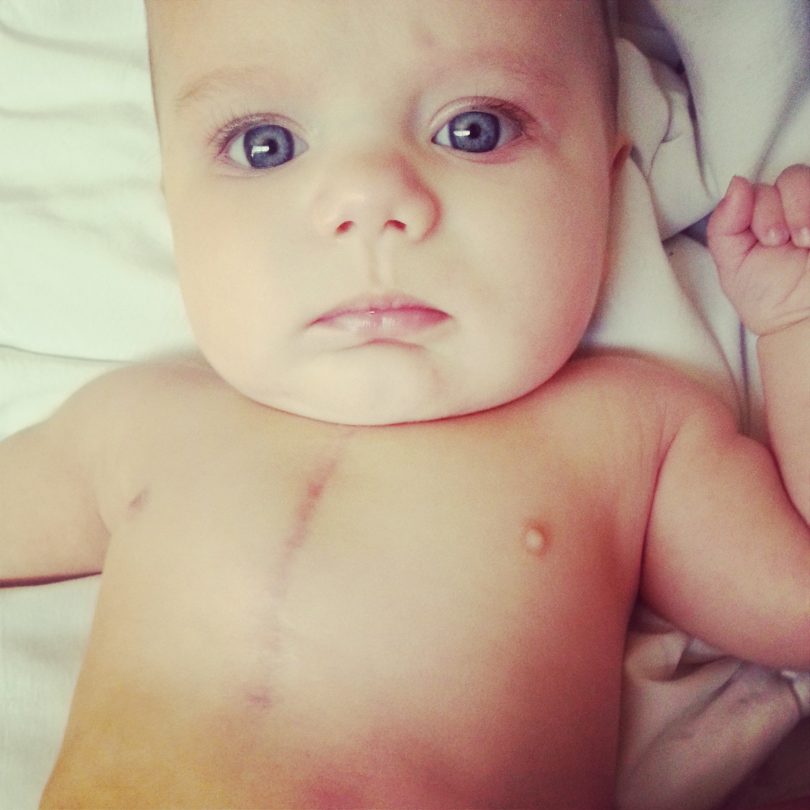Baby Keaton was McKenzie Puffenbarger’s miracle baby. Born with a single fallopian tube, Puffenbarger was told she could never get pregnant. So when she discovered that she was with child, she was over the moon. “I was so excited,” says Puffenbarger. “When we went in to find out the sex, I was really excited to see a big ol’ boy part,” she laughs.
During a check-up, she was engaging in conversation with her chatty sonogram technician. Suddenly it got quiet. Uncomfortable quiet.
“The doctor said that there were a few things that they couldn’t explain and that they were sending me to see a specialist,” she recalls.
The next day she went to Eastern Virginia Medical School as instructed. Within 20 minutes of the exam, she was told that there was difficulty locating Keaton’s heartbeat and deformations existed—one leg was shorter than the other and his kidney function was not good. To top it off, she was told there was a chance he may be born with Down syndrome.
“Hearing all of that was pretty traumatizing,” Puffenbarger remembers.
Good news arrived a month later when she learned that her child did not have Down syndrome. But nothing could have prepared her for what would happen next.
“The plan was to induce labor, have Keaton and all would be well,” states Puffenbarger, “but we had an emergency C-section after 21 hours in labor.”
When Keaton arrived, her beautiful bundle was taken from her within two minutes and rushed to the NICU at Children’s Hospital of the King’s Daughters. There, she stayed by his side day and night waiting to discover what was happening with her newborn. That’s when Keaton’s doctors ran some tests and told Puffenbarger that he had Complete Atrioventricular Canal defect (CAVC) and needed a heart repair, but that he was too fragile to undergo it. The family would have to take Keaton home for six months so that he could pick up additional weight and be a little sturdier for the procedure. However, before being discharged, another problem surfaced.
“Keaton was sweating as if he were running a marathon in his sleep,” says Puffenbarger. “He was drowning from the inside. His heart valve was leaking so much blood. Since he was born with a single heart valve, all of his blood was mixing in one chamber.”
Had Keaton gone home for those six months, he would have died. Instead, he received a five-hour pulmonary artery banding procedure to slow the leaking of blood caused by the Complete Atrioventricular Canal defect.
The surgery was a success and while Keaton was recovering and resting, the nurse suggested that Puffenbarger go home and rest. So she went home and showered. That’s when she saw a missed call from CHKD. The euphoria she felt following the surgery was replaced by dread and panic.
“I felt horrible. I was almost certain that he was dead,” she says. “We sped towards the hospital and I called them along the way. They told me to pull over to the side of the road. That’s when they said that he was being resuscitated. Keaton had suffered a cardiac arrest.”
His chest was reopened and for the next three days, his heart was left exposed. By the fourth day, he was stable.
“He was finally discharged and we brought him home. There was a lot of adjusting, but it was beautiful,” says Puffenbarger. “There is comfort and safety knowing you have a great team of cardiologists around you.”
Within six months, however, things would again get a little rocky as Puffenbarger learned that Keaton would still need a full repair of his AV canal, the final step in repairing the large hole in his heart from his Complete Atrioventricular Canal defect.
“I asked the cardiologist if we were in the best place possible for the surgery,” Puffenbarger explains. “He gave me a weird look, closed his office door and said, ‘No.’ Then he asked what kind of insurance I had.”
The conversation led to her selecting Dr. Spay from Philadelphia. Puffenbarger sold her house, refinanced her vehicle and began to look for a new place to live. All of this to help pay for her son’s needed surgery.
On September 23, 2013, Keaton had a full repair. Outside the possibility of a valve replacement, he won’t need another surgery.
“The surgery was amazing and the technology would blow your mind,” says Puffenbarger. “I never knew that heart disease was the number one birth defect in children. I didn’t know a lot of things that I do now.”
Learn more about the American Heart Association, and volunteer opportunities at heart.org.







